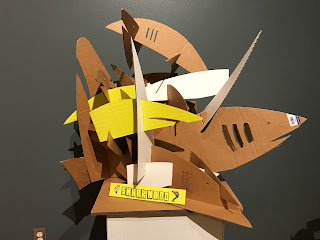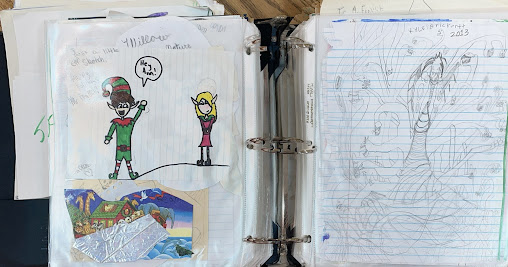Giving Emergent Curriculum a Go - Cardboard Style
Over the last 6 months or so, Clyde Gaw and I have been practicing emergent curriculum ourselves.
Back in August, an acquaintance of ours approached Clyde and me with an offer to be artists-in-residence at the Indiana State Museum during their Cardboard Engineering exhibit. It took us about two seconds to say yes. It was a no-brainer. We would be building cardboard pieces along-side exhibit goers and interact with them while they built. We've been working with cardboard a long time and we're excited to get to show off what we could do in a great venue like the ISM. I first thing to come out of our little experiment was Sharknado. This sculpture took about twenty-minute to build during an early press-only event.
 After the Mesmerizer we moved on to what we were comfortable with: marble runs. We began by stacking 3 four foot tubes together for the base. That's 12 feet tall! Once we had the support figured out, I had to engineer an elevator to lift the marbles to the top. Once I figured it out, it was just a matter of attaching the tracks that would carry the marbles around. But I wanted to mix things up a bit. After the marbles traveled down about 10 feet of track, they emptied into a scrambler. Depending on their velocity or trajectory, the marbles could go to any of three possible shoots. One they had chosen their path it was about another 30 feet until they entered the spin cycle. I had found a circle of cardboard that had two holes in the bottom that would make perfect return holes. All I did was put a fence around the outside to prevent the marble from escaping, removed a small section so I could create a shallow cone. When the marbles entered at an angle, the marbles would run around and around until the dropped. in one of the holes. They would then drop to the return section. It was a really neat marble run.
After the Mesmerizer we moved on to what we were comfortable with: marble runs. We began by stacking 3 four foot tubes together for the base. That's 12 feet tall! Once we had the support figured out, I had to engineer an elevator to lift the marbles to the top. Once I figured it out, it was just a matter of attaching the tracks that would carry the marbles around. But I wanted to mix things up a bit. After the marbles traveled down about 10 feet of track, they emptied into a scrambler. Depending on their velocity or trajectory, the marbles could go to any of three possible shoots. One they had chosen their path it was about another 30 feet until they entered the spin cycle. I had found a circle of cardboard that had two holes in the bottom that would make perfect return holes. All I did was put a fence around the outside to prevent the marble from escaping, removed a small section so I could create a shallow cone. When the marbles entered at an angle, the marbles would run around and around until the dropped. in one of the holes. They would then drop to the return section. It was a really neat marble run.

It was around December when we were thinking or our piece-de-resistance. Clyde was very excited to build a 40 ft dinosaur. He has always been interested in dinosaurs and really wanted to challenge us to do it. I was totally in agreement at that point. He started working on the legs and spine at school when during a conversation, our idea had to be changed. Instead of building a 40 ft dinosaur, the museum was thinking more along the lines of a Mastodon. Who builds a Mastodon? We couldn't just look at a set of instructions? There wasn't a book for that. So we had to look at the Mastodon in the museum collection to get an idea of size and scale.

Our finished Mastodon is on display for a short time at the Indiana State Museum. He hopefully will be moved to the Indiana Geological Society building in Bloomington, Indiana.
Back in August, an acquaintance of ours approached Clyde and me with an offer to be artists-in-residence at the Indiana State Museum during their Cardboard Engineering exhibit. It took us about two seconds to say yes. It was a no-brainer. We would be building cardboard pieces along-side exhibit goers and interact with them while they built. We've been working with cardboard a long time and we're excited to get to show off what we could do in a great venue like the ISM. I first thing to come out of our little experiment was Sharknado. This sculpture took about twenty-minute to build during an early press-only event.
The next time we showed up at the museum we were getting ready for the National Cardboard Day event at the museum. They were hosting a cardboard challenge to build games in honor of Caine's Arcade. If you haven't seen it, you should watch it. Clyde and I started working on a large, gravity controlled, Puahinko game called the Mesmerizer. It was when we started working on this piece that we realized how emergent curriculum works. We didn't have a plan. We didn't have a set of intrusions. However, we tried things, experimented and discovered how everything works. See the video below.
 After the Mesmerizer we moved on to what we were comfortable with: marble runs. We began by stacking 3 four foot tubes together for the base. That's 12 feet tall! Once we had the support figured out, I had to engineer an elevator to lift the marbles to the top. Once I figured it out, it was just a matter of attaching the tracks that would carry the marbles around. But I wanted to mix things up a bit. After the marbles traveled down about 10 feet of track, they emptied into a scrambler. Depending on their velocity or trajectory, the marbles could go to any of three possible shoots. One they had chosen their path it was about another 30 feet until they entered the spin cycle. I had found a circle of cardboard that had two holes in the bottom that would make perfect return holes. All I did was put a fence around the outside to prevent the marble from escaping, removed a small section so I could create a shallow cone. When the marbles entered at an angle, the marbles would run around and around until the dropped. in one of the holes. They would then drop to the return section. It was a really neat marble run.
After the Mesmerizer we moved on to what we were comfortable with: marble runs. We began by stacking 3 four foot tubes together for the base. That's 12 feet tall! Once we had the support figured out, I had to engineer an elevator to lift the marbles to the top. Once I figured it out, it was just a matter of attaching the tracks that would carry the marbles around. But I wanted to mix things up a bit. After the marbles traveled down about 10 feet of track, they emptied into a scrambler. Depending on their velocity or trajectory, the marbles could go to any of three possible shoots. One they had chosen their path it was about another 30 feet until they entered the spin cycle. I had found a circle of cardboard that had two holes in the bottom that would make perfect return holes. All I did was put a fence around the outside to prevent the marble from escaping, removed a small section so I could create a shallow cone. When the marbles entered at an angle, the marbles would run around and around until the dropped. in one of the holes. They would then drop to the return section. It was a really neat marble run. 
It was around December when we were thinking or our piece-de-resistance. Clyde was very excited to build a 40 ft dinosaur. He has always been interested in dinosaurs and really wanted to challenge us to do it. I was totally in agreement at that point. He started working on the legs and spine at school when during a conversation, our idea had to be changed. Instead of building a 40 ft dinosaur, the museum was thinking more along the lines of a Mastodon. Who builds a Mastodon? We couldn't just look at a set of instructions? There wasn't a book for that. So we had to look at the Mastodon in the museum collection to get an idea of size and scale.

Once we put the legs and spine together, Clyde said to me "We should be done in three days" HA! What we thought was a three day tour ended up taking about 200 hours. But once we got the basic structure down ie the skeleton or armature we started building out. First the ribs, then the trunk, the tail, the mouth etc. Once we were done with those parts we began the weaving in and out of cardboard strips that would give the illusion of skin.
















Comments
Post a Comment